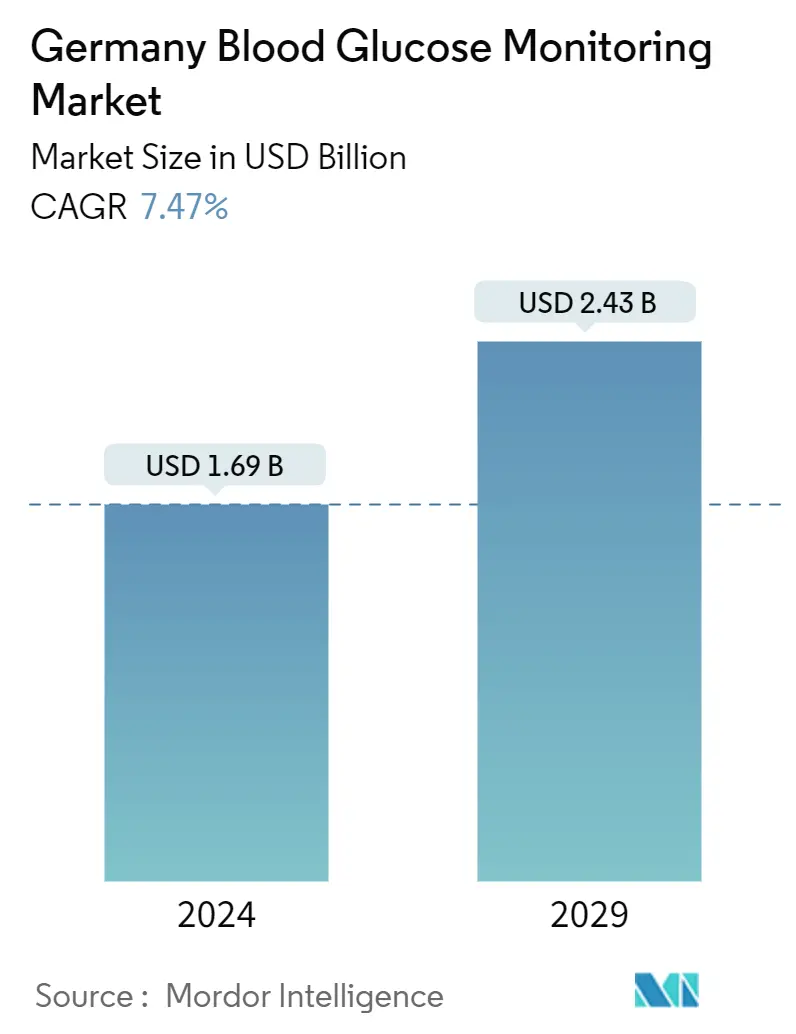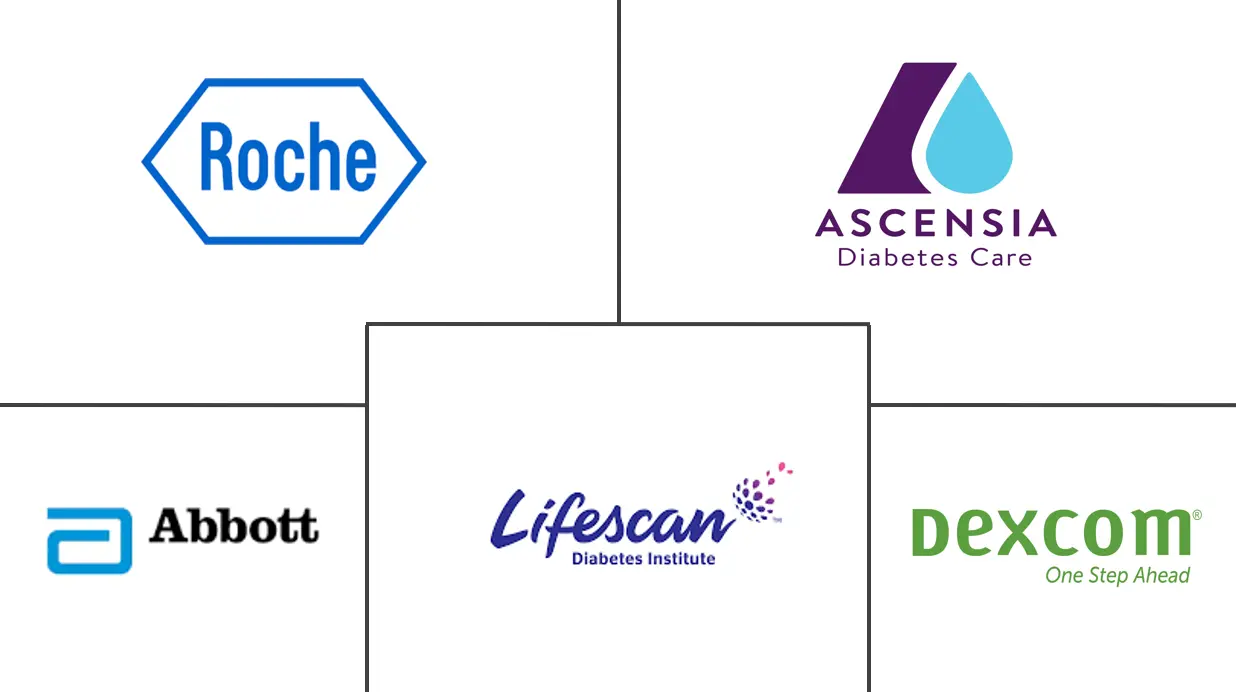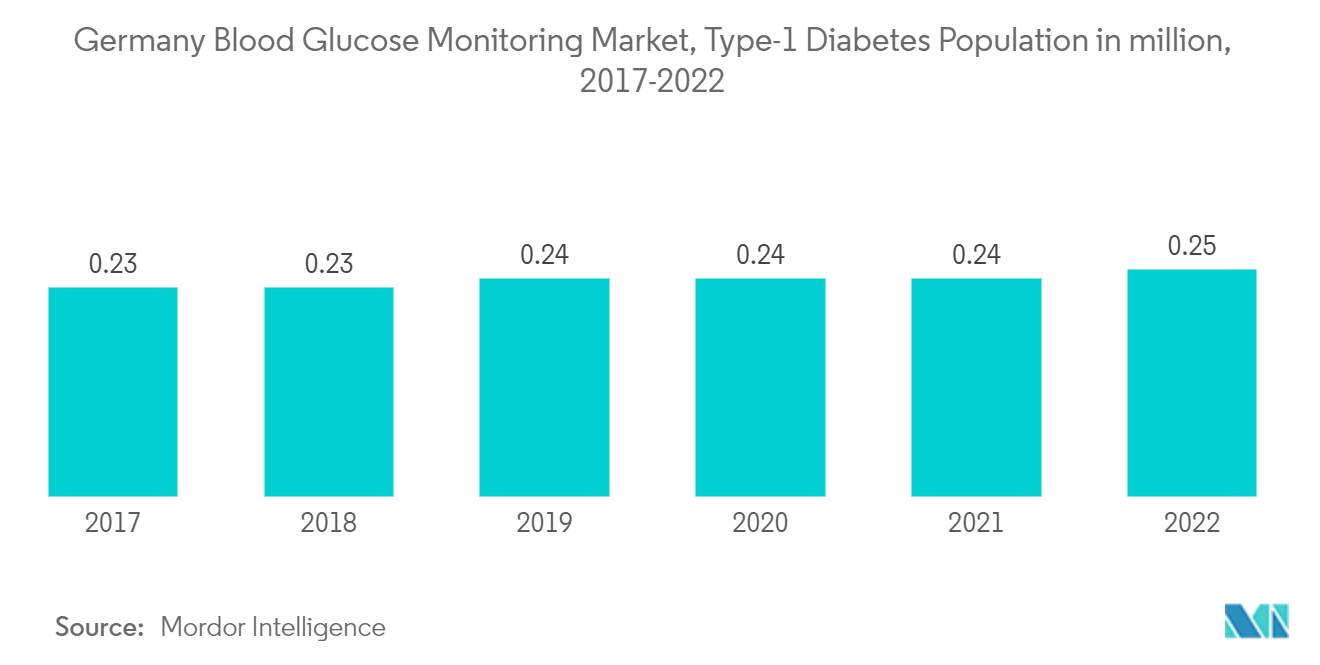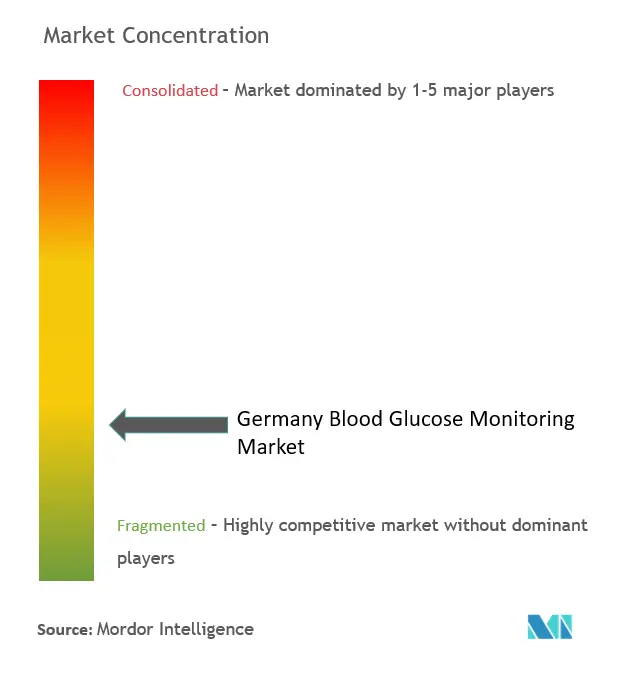Germany Blood Glucose Monitoring Market Size

| Study Period | 2019- 2029 |
| Base Year For Estimation | 2023 |
| Forecast Data Period | 2024 - 2029 |
| Market Size (2024) | USD 1.69 Billion |
| Market Size (2029) | USD 2.43 Billion |
| CAGR (2024 - 2029) | 7.47 % |
Major Players
*Disclaimer: Major Players sorted in no particular order |
Germany Blood Glucose Monitoring Market Analysis
The Germany Blood Glucose Monitoring Market size is estimated at USD 1.69 billion in 2024, and is expected to reach USD 2.43 billion by 2029, growing at a CAGR of 7.47% during the forecast period (2024-2029).
One of the most significant risk factors for severe COVID-19 was diabetes mellitus. This risk was believed to be influenced by several variables frequently present in diabetes mellitus, such as advanced age, hyperglycemia, and underlying conditions (hypertension, cardiovascular disease, chronic kidney disease, and obesity). Diabetes was quickly recognized as a risk factor for bad results during the COVID-19 pandemic, so managing or delaying diabetes became more important than ever before. Following a COVID-19 infection, various studies suggested that reduced numbers of insulin secretory granules in beta cells and impaired glucose-stimulated insulin secretion were observed in the affected patients. In addition, post the pandemic, some patients developed insulin resistance and had elevated blood glucose levels, although they had no previous history of diabetes.
Blood glucose monitoring observes patterns in the fluctuation of blood glucose levels in response to diet, exercise, medications, and pathological processes associated with blood glucose fluctuations such as diabetes. Unusually high or low blood glucose levels can potentially lead to acute and or chronic, life-threatening conditions. Managing diabetes to improve patient outcomes requires a complex multidisciplinary approach. Appropriate and timely blood glucose monitoring allows the successful management of out-of-range blood glucose levels, minimizing diabetic-related health complications.
Diabetes is associated with many health complications. Comparing the population with and without diabetes, those with diabetes have an increased risk of being hospitalized and, thus, incur more healthcare expenses than non-diabetic people. People with diabetes face a higher chance of experiencing serious complications. Germany is one of the developed countries and advanced healthcare facilities. Technologies like continuous glucose monitoring are getting more rapidly adopted in Germany than in other developing countries. Moreover, reimbursement and pricing policies are highly regulated, which drives the market and increases the adoption rate of new and advanced technologies.
Germany Blood Glucose Monitoring Market Trends
Rising diabetes prevalence is likely to boost the market studied over the forecast period.
In Germany, the diabetes population is expected to increase with a CAGR of about 0.48% over the forecast period.
According to the German Diabetes Centre (DDZ) 2022, about 8.5 million people in Germany are affected by diabetes. The number of people with type 2 diabetes in Germany will continue to increase over the next twenty years. Researchers at DDZ estimate that up to twelve million people might suffer from metabolic disorders in 2040.
According to European Observatory on Health Systems and Policies 2021, Germany has the oldest social health insurance system. Health insurance is compulsory. People with an income above a fixed threshold or belonging to a particular professional group can opt out of social health insurance coverage and enroll in private health insurance. About 11 % of the population is covered by private health insurance, 89% by social health insurance. Although coverage is universal for all legal residents, only 0.1 % of the population does not have health insurance.
Diabetes can be considered a data management disease, and an example of real-world acquisition of health and treatment data informs an integrated and personalized chronic disease management. Both patients and diabetes care providers use continuously collected metabolic, treatment, and lifestyle data in joint decision-making on treatment-digital health technologies, including digital health applications, support diabetes self-management.
The vast range of apps in the diabetes field supports the adoption of lifestyle interventions for the prevention and management of diabetes, the evaluation of blood glucose control quality, and the dosing of insulin. Integration of Blood Glucose Monitoring with insulin calculators, automated insulin titration software, and remote coaching are further developments that provide patients with poorly controlled diabetes additional support needed to improve critical outcomes, thereby enhancing the market prospects in the years to come.

The continuous glucose monitoring segment is expected to witness the highest growth rate over the forecast period
The Continuous Glucose Monitoring Segment is expected to witness the highest CAGR of 10.7% over the forecast period.
Continuous glucose monitoring sensors use glucose oxidase to detect blood sugar levels. Glucose oxidase converts glucose to hydrogen peroxidase, which reacts with the platinum inside the sensor, producing an electrical signal to be communicated to the transmitter. Sensors are the most important part of continuous glucose Monitoring. Technological advancements to improve the accuracy of the sensors are expected to drive segment growth during the forecast period.
Researchers are trying to find and develop alternatives to electrochemical-based glucose sensors and create more affordable, minimally invasive, and user-friendly CGM sensors. Optical measurement is a promising platform for glucose sensing. Some technologies have been reported to have high potential in continuous glucose sensing, including spectroscopy, fluorescence, holographic technology, etc. Eversense, a CGM sensor based on fluorescence sensing developed by Senseonics Company, presents a much longer lifespan than electrochemical sensors.
The frequency of monitoring glucose levels depends on the type of diabetes, which varies from patient to patient. Type-1 diabetic patients need to check their blood glucose levels regularly to monitor their blood glucose levels and adjust the insulin dosing accordingly. The expenditure incurred by Type-1 diabetic patients on these devices is nearly double that of Type-2 diabetics. The current CGM devices show a detailed representation of blood glucose patterns and tendencies compared to a routine check of glucose levels at set intervals.
Furthermore, the current continuous glucose monitoring devices can either retrospectively display the trends in blood glucose levels by downloading the data or give a real-time picture of glucose levels through receiver displays. The newest CGM models, the Abbott Freestyle Libre 3 and the Dexcom G7, overcame many technical barriers. Continuous glucose monitoring devices are becoming cheaper with the advent of new technologies, like cell phone integration, which is likely to drive the segment growth during the forecast period.

Germany Blood Glucose Monitoring Industry Overview
The German Blood Glucose Monitoring Market is fragmented, with few significant and other generic players. There have been constant innovations driven by manufacturers such as Abbott and Medtronic while also adhering to organic growth strategies, which is evident from the R&D spending of these companies.
Germany Blood Glucose Monitoring Market Leaders
-
Lifescan
-
Dexcom
-
Roche Diabetes Care
-
Abbott Diabetes Care
-
Ascensia Diabetes Care
*Disclaimer: Major Players sorted in no particular order

Germany Blood Glucose Monitoring Market News
- January 2023: LifeScan announced that the peer-reviewed Journal of Diabetes Science and Technology published Improved Glycemic Control Using a Bluetooth Connected Blood Glucose Meter and a Mobile Diabetes App: Real-World Evidence From Over 144,000 People With Diabetes, detailing results from a retrospective analysis of real-world data from over 144,000 people with diabetes - one of the largest combined blood glucose meter and mobile diabetes app datasets ever published.
- January 2022: Roche launched its new point-of-care blood glucose monitor designed for hospital professionals, with a companion device shaped like a touchscreen smartphone that will run its own apps. The hand-held Cobas pulse includes an automated glucose test strip reader as well as a camera and touchscreen for logging other diagnostic results. It's designed to be used with patients of all ages, including neonates and people in intensive care.
Germany Blood Glucose Monitoring Market Report - Table of Contents
1. INTRODUCTION
1.1 Study Assumptions and Market Definition
1.2 Scope of the Study
2. RESEARCH METHODOLOGY
3. EXECUTIVE SUMMARY
4. MARKET DYNAMICS
4.1 Market Overview
4.2 Drivers
4.3 Restraints
4.4 Porter's Five Forces Analysis
4.4.1 Bargaining Power of Suppliers
4.4.2 Bargaining Power of Consumers
4.4.3 Threat of New Entrants
4.4.4 Threat of Substitute Products and Services
4.4.5 Intensity of Competitive Rivalry
5. MARKET SEGMENTATION
5.1 Type
5.1.1 Self-monitoring blood glucose devices
5.1.1.1 Glucometer Devices
5.1.1.2 Test Strips
5.1.1.3 Lancets
5.1.2 Continuous blood glucose monitoring devices
5.1.2.1 Sensors
5.1.2.2 Durables (Receivers and Transmitters)
5.2 Distribution Channel
5.2.1 Online
5.2.2 Offline
6. MARKET INDICATORS
6.1 Type-1 Diabetes population
6.2 Type-2 Diabetes population
7. COMPETITIVE LANDSCAPE
7.1 COMPANY PROFILES
7.1.1 Abbott Diabetes Care
7.1.2 Roche Diabetes Care
7.1.3 LifeScan
7.1.4 Dexcom Inc.
7.1.5 Medtronic PLC
7.1.6 Arkray Inc.
7.1.7 Ascensia Diabetes Care
7.1.8 Agamatrix Inc.
7.1.9 Bionime Corporation
7.1.10 Acon Laboratories Inc.
7.1.11 Trivida Health
- *List Not Exhaustive
7.2 COMPANY SHARE ANALYSIS
7.2.1 Self-monitoring Blood Glucose Devices
7.2.1.1 Abbott Diabetes Care
7.2.1.2 Roche Diabetes Care
7.2.1.3 LifeScan
7.2.1.4 Others
7.2.2 Continuous Glucose Monitoring Devices
7.2.2.1 Dexcom Inc.
7.2.2.2 Medtronic PLC
7.2.2.3 Abbott Diabetes Care
7.2.2.4 Others
8. MARKET OPPORTUNITIES AND FUTURE TRENDS
Germany Blood Glucose Monitoring Industry Segmentation
Blood Glucose Monitoring Devices are used to diagnose both hyperglycemic and hypoglycemic conditions in diabetic patients. The German blood Glucose Monitoring Market is segmented into Type and Component. The report offers the market size in value terms in USD and volume in units for all the abovementioned segments.
| Type | |||||
| |||||
|
| Distribution Channel | |
| Online | |
| Offline |
Germany Blood Glucose Monitoring Market Research FAQs
How big is the Germany Blood Glucose Monitoring Market?
The Germany Blood Glucose Monitoring Market size is expected to reach USD 1.69 billion in 2024 and grow at a CAGR of 7.47% to reach USD 2.43 billion by 2029.
What is the current Germany Blood Glucose Monitoring Market size?
In 2024, the Germany Blood Glucose Monitoring Market size is expected to reach USD 1.69 billion.
Who are the key players in Germany Blood Glucose Monitoring Market?
Lifescan, Dexcom, Roche Diabetes Care, Abbott Diabetes Care and Ascensia Diabetes Care are the major companies operating in the Germany Blood Glucose Monitoring Market.
What years does this Germany Blood Glucose Monitoring Market cover, and what was the market size in 2023?
In 2023, the Germany Blood Glucose Monitoring Market size was estimated at USD 1.56 billion. The report covers the Germany Blood Glucose Monitoring Market historical market size for years: 2019, 2020, 2021, 2022 and 2023. The report also forecasts the Germany Blood Glucose Monitoring Market size for years: 2024, 2025, 2026, 2027, 2028 and 2029.
Germany Blood Glucose Industry Report
Statistics for the 2024 Germany Blood Glucose market share, size and revenue growth rate, created by Mordor Intelligence™ Industry Reports. Germany Blood Glucose analysis includes a market forecast outlook to 2029 and historical overview. Get a sample of this industry analysis as a free report PDF download.



